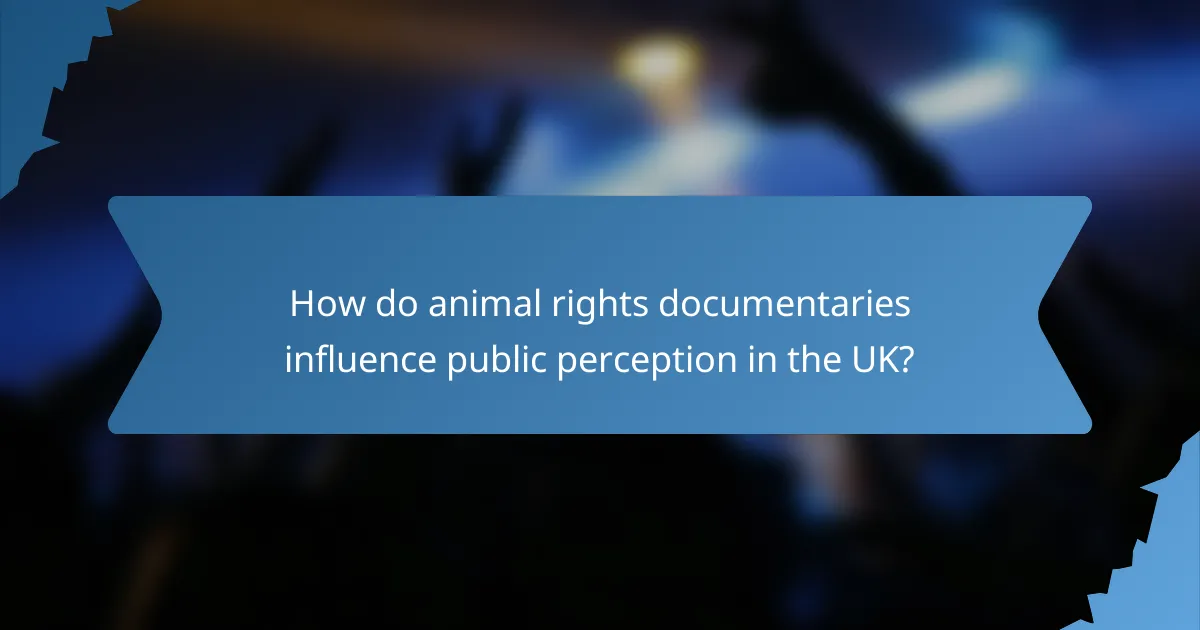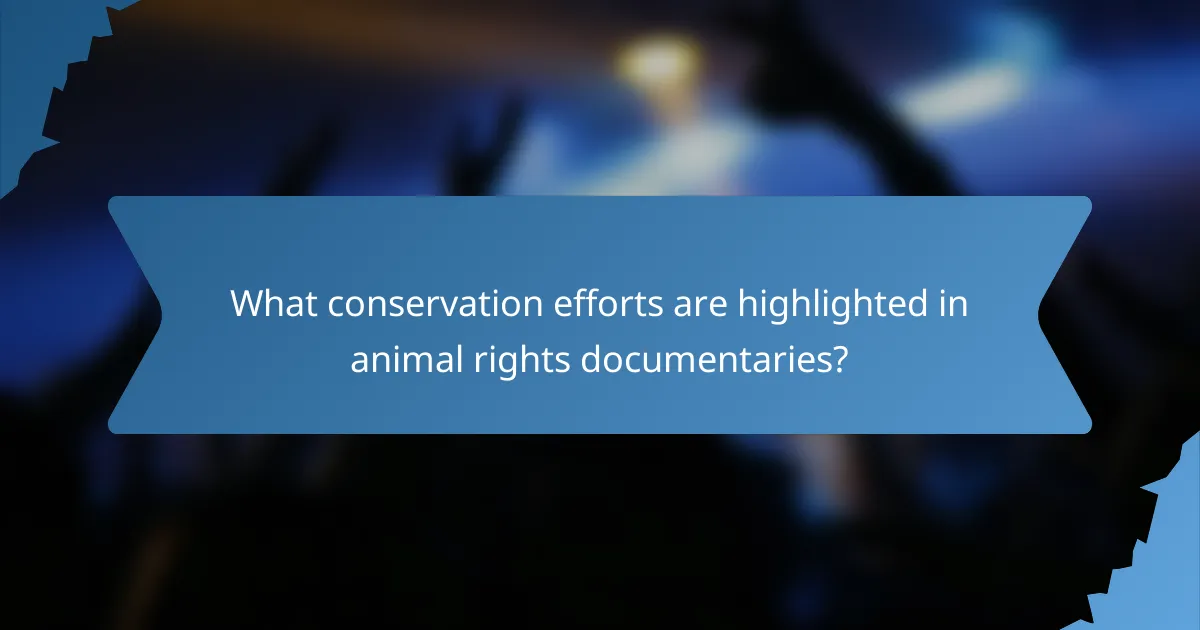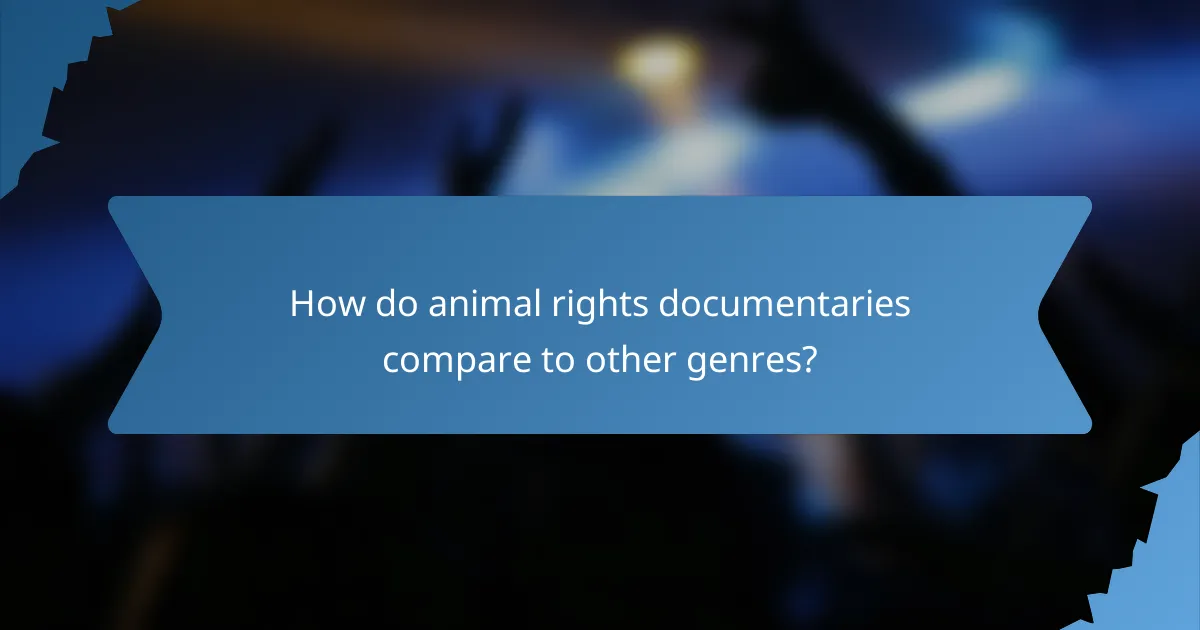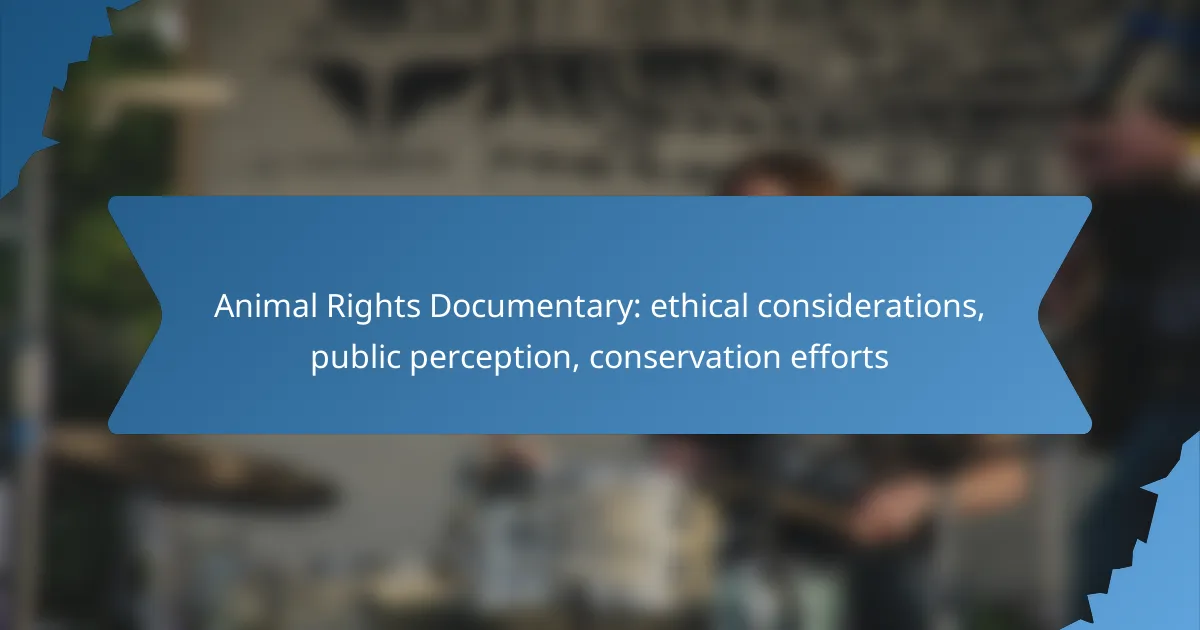Animal rights documentaries play a crucial role in shaping ethical discussions surrounding animal welfare and the responsibilities of filmmakers in representing these issues. By raising awareness and influencing public perception, these films challenge viewers to reconsider their beliefs and engage in conservation efforts aimed at protecting wildlife and their habitats.

What are the ethical considerations of animal rights documentaries?
Animal rights documentaries raise significant ethical considerations, primarily focusing on the portrayal of animal suffering, the responsibilities of filmmakers, and the impact on public perception. These films aim to highlight issues surrounding animal welfare while navigating the complex moral landscape of representation and consent.
Representation of animal suffering
Documentaries often depict animal suffering to evoke emotional responses and raise awareness. However, the portrayal must balance authenticity with sensitivity to avoid sensationalism. Ethical representation involves showing the reality of animal conditions while respecting their dignity.
Filmmakers should consider the context and purpose of the footage, ensuring it serves to inform and advocate rather than merely shock. This approach fosters a more constructive dialogue about animal rights and welfare.
Impact on viewer perception
The way animal suffering is presented can significantly influence viewer attitudes and behaviors towards animal rights. Documentaries that effectively convey the plight of animals can inspire empathy and motivate action, such as supporting conservation efforts or changing dietary habits.
Conversely, overly graphic content may lead to desensitization or backlash, where viewers become numb to the issues presented. Striking a balance in presentation is crucial to maintain engagement and promote positive change.
Filmmaker responsibilities
Filmmakers have a responsibility to ensure their work is ethical and truthful. This includes conducting thorough research and representing facts accurately. They should also strive to amplify the voices of advocates and experts in the field rather than solely relying on sensational imagery.
Additionally, filmmakers should consider the potential consequences of their work, including how it may affect animal welfare policies and public opinion. Engaging with stakeholders and communities can enhance the film’s impact and credibility.
Consent and agency of subjects
When documenting animal rights issues, filmmakers must consider the consent and agency of the subjects involved. While animals cannot provide consent in the traditional sense, ethical practices involve minimizing harm and distress during filming.
Filmmakers should prioritize the welfare of animals, ensuring that their methods do not exploit or endanger them. Collaborating with animal welfare organizations can provide guidance on ethical practices and enhance the film’s integrity.
Use of graphic content
The use of graphic content in animal rights documentaries is a contentious issue. While such imagery can effectively convey the severity of animal suffering, it can also alienate viewers or provoke negative reactions. Filmmakers should weigh the potential benefits against the risks of desensitization.
To mitigate adverse effects, filmmakers can consider using less graphic but still impactful storytelling techniques, such as personal narratives or testimonials from those involved in animal welfare. This approach can foster a deeper understanding without overwhelming the audience.

How do animal rights documentaries influence public perception in the UK?
Animal rights documentaries significantly shape public perception in the UK by raising awareness about animal welfare issues and influencing attitudes towards conservation efforts. These films often challenge viewers to reconsider their beliefs and behaviors regarding animal rights, prompting discussions and actions that can lead to societal change.
Shifts in public attitudes
Documentaries have been instrumental in shifting public attitudes towards animal rights by highlighting the ethical implications of animal exploitation. As viewers engage with compelling narratives, they often develop a greater empathy for animals, leading to increased support for animal welfare initiatives.
Surveys indicate that after viewing impactful documentaries, a notable percentage of the audience may adopt vegetarian or vegan diets, reflecting a tangible change in lifestyle choices. This shift demonstrates the power of visual storytelling in altering perceptions and behaviors.
Case studies of impactful films
Films such as “Blackfish” and “Earthlings” have had profound effects on public awareness and policy regarding animal rights. “Blackfish,” which focuses on the treatment of orcas in captivity, sparked widespread outrage and led to significant changes in how marine parks operate.
Another example is “Cowspiracy,” which explores the environmental impact of animal agriculture. This documentary has encouraged many viewers to reconsider their dietary choices and has spurred discussions about sustainable practices within the agricultural sector.
Role of social media
Social media plays a crucial role in amplifying the messages of animal rights documentaries, allowing them to reach a broader audience. Platforms like Twitter, Instagram, and Facebook enable users to share their thoughts and experiences, fostering community engagement around animal welfare issues.
Hashtags related to specific documentaries often trend, creating a ripple effect that can lead to increased viewership and activism. This online discourse not only raises awareness but also encourages collective action, such as petitions and campaigns aimed at improving animal rights legislation in the UK.

What conservation efforts are highlighted in animal rights documentaries?
Animal rights documentaries often spotlight various conservation efforts aimed at protecting wildlife and their habitats. These films typically emphasize the importance of preserving biodiversity through targeted initiatives that engage communities and collaborate with organizations dedicated to conservation.
Focus on endangered species
Documentaries frequently center on endangered species, showcasing the critical need for their protection. These films illustrate the threats faced by these animals, such as habitat loss, poaching, and climate change, while highlighting successful recovery stories. For instance, initiatives that have helped species like the California condor or the Amur leopard serve as powerful examples of effective conservation efforts.
Community engagement initiatives
Community engagement is vital for successful conservation, and many documentaries highlight programs that involve local populations in protecting wildlife. These initiatives often include educational workshops, eco-tourism, and sustainable practices that empower communities to take an active role in conservation. By fostering a sense of ownership and responsibility, these efforts can lead to more sustainable outcomes for both wildlife and local economies.
Partnerships with conservation organizations
Collaborations with established conservation organizations are frequently showcased in animal rights documentaries. These partnerships can amplify the impact of conservation efforts through shared resources, expertise, and funding. Documentaries may highlight successful alliances, such as those between local NGOs and international bodies, which have led to significant advancements in habitat restoration and species protection.

What frameworks guide the production of ethical documentaries?
Ethical documentaries are guided by frameworks that prioritize the welfare of subjects, transparency in storytelling, and respect for cultural contexts. Filmmakers must balance artistic expression with moral responsibilities to ensure that their work does not exploit or harm the individuals and communities depicted.
Best practices for filmmakers
Filmmakers should prioritize informed consent, ensuring that all participants understand the purpose of the documentary and how their stories will be used. This includes providing clear information about potential risks and benefits associated with participation.
Additionally, filmmakers should strive for accuracy and fairness in representation, avoiding sensationalism and stereotypes. Engaging with the communities being documented can foster trust and lead to more authentic storytelling.
Ethical guidelines from organizations
Various organizations offer ethical guidelines for documentary filmmakers. The International Documentary Association (IDA) emphasizes the importance of integrity, urging filmmakers to represent their subjects truthfully and with respect.
Similarly, the Association of Independent Video and Filmmakers (AIVF) provides resources that encourage ethical practices, such as maintaining transparency about funding sources and avoiding conflicts of interest. Adhering to these guidelines can enhance the credibility and impact of a documentary.

How do animal rights documentaries compare to other genres?
Animal rights documentaries differ from other film genres primarily in their focus on ethical issues surrounding animal treatment and conservation. They aim to educate viewers about the plight of animals, often prompting emotional responses and calls to action, unlike narrative films that prioritize storytelling and entertainment.
Documentary vs. narrative films
Documentaries are grounded in factual content, presenting real-life events and issues, while narrative films typically involve scripted stories and fictional characters. This distinction allows animal rights documentaries to provide a platform for authentic voices and experiences, making the ethical considerations more impactful.
For example, a documentary like “Earthlings” uses real footage to expose animal cruelty, whereas a narrative film might depict a fictional story about a character’s relationship with animals. This difference in approach can lead to varying audience perceptions and emotional engagement.
When creating or viewing animal rights documentaries, consider the ethical implications of the content. Ensure that the portrayal of animals is respectful and accurate, and be mindful of how the documentary might influence public perception and conservation efforts.
